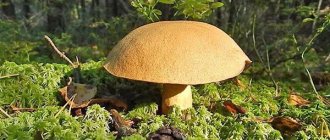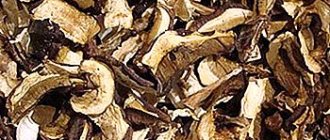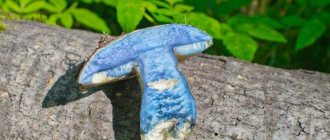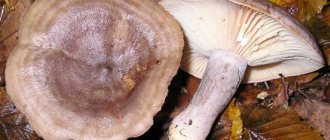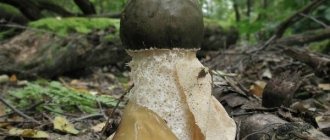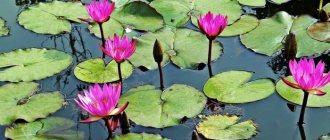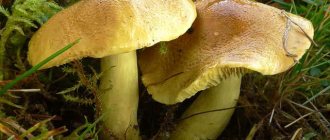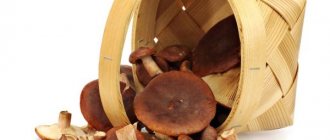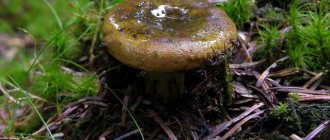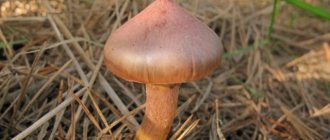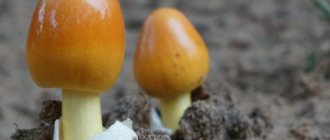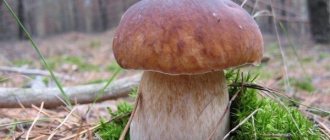What does a serushka mushroom look like?
As the name suggests, the mushroom is gray in color. But it can change at different times of the year. Thus, the cap of the autumn serushka mushroom is painted in different shades of gray: from violet-pink to dark lead.
Serushka has many different names that reflect its color peculiarities: gray milkweed, greenfinch, gray row, lilac milk mushroom, serukha, seryanka.
While the mushroom is growing, the entire surface of its cap has a convex shape.
In its mature state, it takes the form of a funnel, in the middle of which there is a small smooth tubercle. The edges look jagged and slightly drooping. The diameter of the cap can reach 10 cm.
There are several main distinctive characteristics that will help you navigate the forest and distinguish this type of mushroom from others:
- The white pulp has a dense texture and a fruity aroma.
- Rarely located plates are painted pale yellow. In young mushrooms they are inseparable from the stem and only with time take on the shape of a wave.
- If a gray mushroom is broken into 2 parts, you can see the release of a watery liquid that has a very pungent taste. Its quantity is always abundant, even in dry weather.
- In mushrooms that have not yet formed, the light gray stem is slightly swollen or, conversely, narrowed. Its thickness is 2 cm, length - 8 cm. In mature ones, it becomes hollow, and its color becomes more saturated.
When wet, during and after precipitation, the surface of the cap becomes very slippery.
The gray mushroom is often confused with zoned and zoneless milkweed, whose caps have cream and brown shades.
Important! Only earrings secrete milky juice, the color of which does not change and remains white all the time.
One of the distinguishing advantages of these mushrooms is that worms usually do not show interest in them, so seruchi are rarely wormy. In some cases, only the lower edges of the legs may be damaged, while the caps always remain intact.
Photos and descriptions of serushka mushrooms will help novice mushroom pickers easily find them in the forest and distinguish them from other species.
Pig mushrooms: description, dangerous or edible
Svinushka mushroom (also known as barnyard, pig's ear, pig's ear, havroshka, dunka, fetyukha) - includes both conditionally edible and poisonous varieties of fruiting bodies. The culture belongs to the pig family and literally translates as “small bag”.
It is found throughout our country, mainly in regions with a temperate climate.
As a rule, mushroom pickers prefer to avoid suspicious fruits that resemble the heels of livestock, but there are also those who put their finds in a basket and then look for information on the use of the product.
Today we will study what pig fruits look like, consider its edible and dangerous varieties, and also discuss the benefits and “treachery” of the plant.
Svinushka mushrooms: description and photo
Svinushki are medium-sized mushrooms, vaguely similar to the milk mushroom familiar to all collectors. The cap of an average barn does not exceed a diameter of 13-16 centimeters; occasionally there are specimens that grow to 20-22 centimeters.
The shape is slightly semicircular, wavy, becomes flat as it ages, and becomes concave towards the end of its life cycle. The edges are smoothly lowered to the ground. The fruit body is dense, fleshy, covered with orange-brown skin.
The surface is dry, with slight roughness; after prolonged contact with water it may become sticky or slimy.
Young representatives of the culture are distinguished by their rich light color; the older the specimen, the darker its color.
The leg is stable, low, maximum 8-9 centimeters long, thickness - from 1 to 2 centimeters. The color is almost the same as the hat. In order to find a use for the fruiting bodies of the plant, it is necessary to collect only some varieties of the family, and in all cases only young ones.
Habitats, growing season
The mushroom grows in small colonies, prefers temperate climates and deciduous, coniferous, mixed forest thickets. When going on a “quiet hunt”, it is first of all recommended to study forest edges and clearings, if the region is characterized by marshy areas - along the outskirts of water bodies.
The pigweed bears fruit in the spring-autumn and summer seasons, from the end of June to mid-October. Does not like severe drought and sudden changes in temperature. If a collector finds a clearing with fruiting bodies, it is productive to inspect the nearby inversions; plant spores often develop on them as well.
Known types of pigs
Today, science has discovered and studied about 35 varieties of the crop we are considering; we present to your attention the most famous fruiting bodies of the family:
Thin pig
It grows in warm regions of the Russian Federation, as well as in the forests of Southern, Central and Eastern Europe. Often found on fallen tree trunks, in swampy areas, on the edges of ravines, among young birches or in oak groves. Loves moisture.
Distinctive features of the variety:
- The cap color of young pig mushrooms is green-brown; the older the fruiting body, the redder its color.
- The height of the leg is 4-6 centimeters, stable, smooth, cylindrical in shape. The color is slightly lighter than the upper part of the mushroom.
- The cap is covered with smooth, dry skin, the average diameter is about 13-15 centimeters.
- The inside of the “head” is strewn with intertwining cells made of wide but fragile plates.
- The spores are smooth, light, slightly oblong in shape.
Thin Barn produces a crop in June and continues to bear fruit until mid-October. Ripens in waves. A few decades ago, the variety was considered conditionally edible and was consumed by some thrill-seekers, but new discoveries have shown that the mushroom contains toxic substances and is dangerous to eat.
Fat pig
The second name of the plant is felt mushroom. It is found often, mainly in European countries that fall under the influence of a temperate climate. Also common in many regions of Russia.
It prefers to grow among coniferous trees, on old or damaged wood, most often on eversion. It is distinguished by its large size (when compared with other members of the family), the average diameter of the mushroom cap is 18-20 centimeters. The shape is asymmetrical, slightly reminiscent of a long cow tongue. The cap is thick, convex, the edges are bent to the stem.
The color of the fat pig varies from dark olive to brown; the surface of young specimens is smooth and velvety to the touch. The older the mushroom, the more uneven its color becomes, and the skin becomes covered with a fine web of cracks.
The pulp is fragile, watery, yellow in color and practically odorless. If you break a mushroom, it turns blue. The side of the mushroom facing the ground is strewn with light plates that darken when damaged. The leg is short, dark, dense, covered with small fibers. Connects to the cap closer to one of the edges.
The felt mushroom is recognized as a conditionally edible crop and is not a delicacy, but many fans of alternative medicine continue to eat it. The main secret of the mushroom is that its chemical composition contains compounds that help fight the occurrence of malignant tumors. Anyone can serve a fat pig on the table, the main thing is to know how to cook it correctly.
Alder pig
It grows in the forests of Germany, the Russian Federation, Belarus, as well as in many European countries. Prefers mixed or deciduous thickets, as well as damp areas. The growing season of mycelium is from mid-summer to the end of September, disappearing with the first frosts.
Externally, the alder mushroom differs significantly from its fellows in shape - the mushroom cap resembles a small funnel with wavy edges lowered to the ground. The maximum diameter of the mushroom is small - up to 9 centimeters. The color varies from beige-yellow to brown-rusty, depending on age and immediate habitat.
The cap is dry, covered with small scales, the flesh is yellow, dense in young specimens and loose if the mushroom is old. Virtually odorless.
The mushroom is frankly poisonous and can cause serious damage to the human body.
Ear-shaped or panus-shaped pig
A distinctive feature of the variety is its completely disproportionate shape. At first glance, it may seem that part of the mushroom is simply torn off from the body - it resembles a fan. Less common are mushrooms that look like an uneven, wavy shell.
The surface of the plant is covered with small villi that form velvet; the older the representative, the fewer villi remain on its surface.
Overgrown panus-shaped pigs become completely smooth, dirty beige in color, while young specimens are painted in beige or yellow tones.
The hat is dense, hard, one might even say tough. The average body size does not grow more than 8-10 centimeters. The leg is almost invisible, grows to a maximum of two centimeters, and fuses with the “head”.
The pulp is hard, reminiscent of pliable rubber; if its structure is damaged, bright spots appear on the surface.
Another distinctive feature of the ear-shaped fruit is the rather rich smell of pine needles. The aroma is determined by the places where the crop grows; the mushroom prefers to appear where coniferous trees predominate.
It develops in small colonies, sometimes single representatives are found. The ideal substrate is dead coniferous wood, fallen “needles” or rotting stumps.
The mushroom is considered poisonous and contains toxins that adversely affect human blood. If a collector goes into the forest in order to get a harvest of delicacy, it is recommended to avoid the ear-shaped pig.
Is the pig edible or still poisonous?
Studying the scope of application of the culture we are considering, we can definitely say that the pig is poisonous to the human body.
Even 70 years ago, the plant was officially considered conditionally edible and was used as food, but since the first half of the 90s of the 20th century, cases of death among people serving such mushrooms on the table have become more frequent. The first death was recorded in the fall of 1944, after the consumption of a dangerous product by a mycologist from Germany, and in 1993 the plant was legally declared poisonous.
Numerous studies of the fruiting bodies of pigweed have revealed what is its catch. The fact is that the chemical composition of the forest fruit contains toxic muscarine and other lectins that are not destroyed even after long-term heat treatments of the fruit.
Also, the pulp of mushrooms is saturated with antigen, which is absorbed into membrane cells, after which the latter are destroyed thanks to the body’s natural defense system. Infected cells are identified as irritants, the body tries to get rid of them, as a result of which the blood suffers greatly, namely, the level of red blood cells decreases. The consequences of such processes can be:
- Acute renal failure;
- Liver damage, up to cirrhosis;
- Hemolytic anemia;
- Nephropathy;
- Poisoning by heavy metals accumulating in the pulp of the pig.
- Malfunctions of the cardiovascular system;
- Damage to some parts of the brain.
In addition to the listed diseases, the fungus can cause a serious allergic reaction, which cannot be overcome without immediate hospitalization.
Despite this, there are still desperate gourmets who prepare pigs for the winter. People adopt the experience of their grandparents, believing that there is no danger in the pulp of pigs. The harvested crop is soaked in cold water for several days, and the liquid is repeatedly replaced with a new one.
Afterwards, the procedure is repeated with the addition of citric acid and salt - it is believed that in this way the maximum amount of toxins with metals “comes out” of the fruit.
At the end of the preparation, the khavroshki are boiled at least three times, only after which they are usually marinated, fried or pickled, like all other edible forest delicacies.
Can pig meat be beneficial?
Going back several decades, we can analyze the “phantom” benefits of pigweed.
Soviet scientists were convinced that the chemical composition of the mushroom is very rich in useful elements necessary for the normal functioning of the human body.
The presence of the listed "components" could and was once used:
- In the treatment of the heart and central nervous system.
- To normalize general hormonal levels (mainly female).
- After infection with viral and infectious diseases.
- To improve sleep and overall strengthen the body.
However, all of the above advantages instantly faded with the appearance of the first deaths from consuming toxic delicacies.
Assessing the benefits and harms of the plant in question, we can clearly conclude that the crop is dangerous to life. At the same time, it is impossible not to note cases when the forest product was used by traditional healers to obtain tinctures and extracts. There is an opinion that such unconventional medicines can help people suffering from malignant neoplasms.
How to recognize the symptoms of pig poisoning
Since the culture we are considering is externally similar to milk mushrooms, it is absolutely not necessary to purposefully collect poisonous mushrooms; you can simply accidentally confuse them with useful ones. It is worth noting that intoxication may not appear immediately, or may not appear at all, but being aware of its expressions is vital.
We present to your attention the symptoms of possible poisoning by mushrooms of the pig family:
- Acute or aching pain in the abdomen, manifested by attacks;
- Nausea, lethargy, persistent vomiting;
- Flatulence, diarrhea;
- Yellowing of the skin all over the body.
- An increase in temperature to a fever that is difficult to bring down with usual medications.
- Decreased frequency and volume of urination.
The results of laboratory tests of poisoned persons may show an increased concentration of hemoglobin in the urine, and oligoanuria may also develop, which indicates serious kidney damage.
If you first suspect poisoning, it is important to immediately contact emergency medical services, having first told the dispatcher the seriousness of the situation.
What help can be provided before the doctors arrive?
Unfortunately, self-medication is completely ineffective for pig poisoning. If the victim has an allergic reaction, antihistamines will help dull the attack.
In all other cases, hemodialysis and cleansing the body using plasmapheresis are vital - without the listed professional measures there is a high risk of death.
(3 4,00 of 5) Loading...
Source: https://moi-gribi.ru/yadovitye/svinushki
Where do earrings grow?
Gray mushrooms are common in deciduous and mixed forests. Experienced mushroom pickers know that they can always be found in aspen and birch thickets, the upper layers of the soil of which receive a lot of light and warm up well.
Some of the popular names of this species help to understand where they most often grow:
- plantain;
- sub-tree;
- gray hollow.
This species grows in large clusters along forest roads, paths, and forest edges. The most preferred are loamy and sandy loam soils. They can also be seen in wetlands and low-lying areas where meltwater does not drain for a long time.
Similar species
There are some similar species to greenfinches:
- Aspen greenfinch (Tricholoma frondosae) is a very similar species, differing in its scaly cap and ecology. It forms mycorrhiza with birch and aspen; in Western Siberia it is recorded in small-leaved-dark-coniferous forests of the Khanty-Mansi Autonomous Okrug. It is very likely that the species is widely distributed in suitable biotopes, and that findings of Tricholoma equestre from dark coniferous-small-leaved forests of the Tomsk and Novosibirsk regions, mentioned in the literature [7], actually refer to T. frondosae.
- Auvergne grass (Tricholoma arvernense) - similar in brownish, mustard and greenish-yellow shades in the color of the cap and is sometimes found at the same time in the same biotopes, but is well distinguished by white plates without yellow shades.
- Sulfur-yellow row (Tricholoma sulphureum) - similar in bright greenish or mustard-yellow tones in color, but is well distinguished by the more uniform color of the fruiting body, sparser plates and a characteristic strong, pungent chemical odor.
- The different or isolated row (Tricholoma sejunctum) and similar species, the slightly different row (T. subsejunctum) and the green-yellowish row (T. viridilutescens) are a little reminiscent of the greenfinch with bright yellow-green tones in color, but differ in habitat, preferring mixed small-leaved and dark coniferous forests , and white coloration of the plates.
- Golden rower, or golden greenfinch (Tricholoma auratum) is a hard-to-distinguish look-alike species with a stickier cap surface; most authors consider it a synonym of T. equestre, however, molecular genetic studies of this group of species have shown that T. auratum specimens from Japan form a branch separate from the bulk of T. equestre specimens and European specimens identified as T. auratum [5]. Only further research can clarify the picture.
- In various reference books and encyclopedias of mushrooms, some similarities between greenfinch and pale grebe (Amanita phalloides) are often noted in light of the danger of confusing these mushrooms when collecting greenfinch for food. The pale grebe, a representative of the fly agaric genus, is reliably distinguished from the greenfinch by the presence of a well-developed membranous ring on the stalk, a large sac-like volva at the base of the stalk, and the white color of the pulp and plates. In Western Siberia, the pale grebe is rare, and the populations known to us are confined to birch forests and artificial oak plantings, however, there are reports of isolated finds of this species in steppe pine forests in the Altai Territory.
Material on the topic: Mushrooms: where to look and when to collect
Perhaps the only common, definitely edible mushroom with a greenish color on the cap remains the green russula (Russula aeruginea). Bright specimens of this russula can be superficially similar to both the greenfinch and the pale toadstool. Green russula differs well from greenfinch by the complete absence of yellow tones in the color of the plates, legs and pulp, which is brittle like chalk. The cap skin of this russula can be easily removed almost to the middle of the radius.
Taste qualities of serushki
In terms of nutritional and taste qualities, this species belongs only to the 3rd food category. Category 1 includes the most delicious and healthy mushrooms, rich in valuable minerals, proteins and vitamins, such as boletus, milk mushrooms, saffron milk caps, champignons and all porcini mushrooms.
Representatives of the 2nd category also have high quality, but a slightly lower content of vitamins and minerals - boletus, boletus, boletus, and boletus. The 3rd category is represented by mushrooms of low quality, which have a good taste, but a poor composition of nutrients and beneficial substances. In addition to the serushka, this category includes mushrooms such as honey mushrooms, morels, milkweeds, certain types of moss mushrooms and some others.
Excessive content of milky juice makes the taste of earrings acrid and bitter. Only due to the content of useful substances they did not fall into the 4th category, which includes all types of mushrooms with a mediocre taste and an insignificant content of microelements: for example, oyster mushrooms, dung beetles, puffballs.
Useful properties of earrings and restrictions on use
This variety has a large number of useful properties, which is associated with its composition. Thus, earrings contain a large amount of amino acids, vitamins, and minerals. Potassium, which is also included in the composition, normalizes the functioning of the heart muscle and blood vessels, restores acid, alkaline, water-salt and electrolyte balance, metabolism of proteins and carbohydrates.
B vitamins prevent the development of gallstones, obesity and nervous system disorders. Phosphorus promotes the growth of the musculoskeletal system, and is also responsible for the transport function in the body.
In folk medicine, infusions and decoctions are used to treat diabetes, cancer, depression and nervous disorders, hypertension, rheumatism, arrhythmia and osteoporosis. Greenfinch has antibacterial, antimicrobial and immunostimulating effects.
Our ancestors often used serushki to treat stomach diseases and even added them to medicine against cholera. Also, this type is often used in dietary nutrition, which is due to their low calorie content and high content of nutrients in the required proportions. Due to their high content of polysaccharides, they are often used as an immunostimulant.
Benefits and harm to the body
In the Middle Ages, eating earrings helped in the treatment of stomach and related diseases. It was included as one of the components in the formulation of drugs for cholera. The microelements they contain are useful for maintaining the functioning of the gastrointestinal tract and have a positive effect on the functioning of the brain and blood vessels.
Due to the significant concentration of polysaccharides that strengthen the immune system, this type of mushroom is often used to prepare various ointments, decoctions and tinctures. They are used to treat skin diseases. Serushki have an antiparasitic effect on the body and cope with various types of worms and worms. These mushrooms are easily digestible and low in calories, so they are recommended even for dietary nutrition.
Important! Adding earrings to the diet helps remove heavy metal salts from the body and cleanse it of toxins.
Mushrooms collected in ecologically clean areas and properly processed will only bring benefits to the human body. However, you should not abuse such foods and eat them in large quantities. Serushki are rich in natural chitin, useful in small doses. If you overeat, digestive problems may occur. The inclusion of mushrooms in the diet is also contraindicated for young children.
It is not recommended to consume earrings for people suffering from diseases associated with disorders of the stomach and intestines. It is allowed to take mushrooms in small quantities, and only in boiled form. If the listed diseases are acute, the product should be completely abandoned. Pickled mushrooms containing vinegar and various spices are especially dangerous in this state.
Salting and marinating
There are two ways to pickle earrings:
- Cold way.
- Hot method.
The cold method is when mushrooms are placed in jars in layers: one layer of mushrooms, the second of salt. Calculate approximately 1 tablespoon per 1 kilogram of serukh. To improve the taste a little, you can also add horseradish leaves, black peppercorns, dill and garlic.
After this, you need to press them down in the jar. To do this, you need to cut a circle out of a birch log and put it in a jar, and put a weight on top. After some time, the serukhs will begin to secrete juice - at this moment you need to put the leaves on top and close the lid.
The hot method is completely different . Here there is no need to soak the mushrooms; they need to be cooked 2-3 times for 15-20 minutes. Each new cooking should begin with clean water, and after cooking they are also compacted into jars.
The jars are placed in a cool place, for example, in the refrigerator, basement or on the balcony. It is worth noting that when salted, the travelers change color and become dark brown, but at the same time very tasty and crispy. In winter, they are useful for preparing salads and pies.
Serushki are unpopular mushrooms among mushroom pickers, most likely due to their unsightly appearance. But those who have tried them claim that mushrooms have an excellent taste, if, of course, they are cooked and soaked correctly.
In addition, they have high yields and are widespread. Therefore, you should not be afraid to collect and consume earrings.
Published on March 16, 2018 by samsonmain. The entry was published in the Conditionally Edible section. Bookmark the permalink.
Delicious roast with mushrooms and potatoes: recipe with beef and chicken
How to deliciously salt oyster mushrooms at home
How to distinguish a serushka from false serushkas
Serushki grow in large clusters forming rounded rows, which is why they are called “witch circles.” To avoid getting poisoned, you should know how to distinguish conditionally edible earrings from their counterparts, which pose a serious threat to life and health:
- White poisonous row. Its flesh, painted white or milky, acquires a pink tint when broken. The stem and cap are white. A distinctive feature is a pungent odor reminiscent of radish.
- Inedible soap semolina. It is characterized by a sharp soapy odor and has a uniform, rich color.
- Pointed earring. It has a very pungent taste and repulsive odor. It is easily distinguished from the real variety by the presence of a high, pointed part in the center of the cap.
All types of false mushrooms can be identified by one common distinctive feature: when broken, representatives of the species emit a sharp, unpleasant odor, and some mushrooms have a repulsive smell even in an untouched state.
Description of greenfinches
Greenfinch is a representative of the Ordinaceae family from the genus Tricholoma. The mushroom received this name for its persistent green tint of color, which is not lost even after heat treatment.
What they look like
Externally, representatives of this species resemble gray rowers. Only greenfinches have a yellow-green color that is quite unusual for mushrooms.
The mushrooms are medium in size. A flat cap with a tubercle in the middle is supported by a thin mushroom stem. Between them there is a row of plates.
The edges of the greenfinch's cap are often uneven. The stems of these mushrooms like to hide in the soil. The surface of the caps is very sticky. Therefore, a variety of forest debris often sticks to it.
Rules for collecting mushrooms
Serushki, like all other mushrooms, perfectly absorb and accumulate harmful substances found in the soil and air. Therefore, they should not be collected in unfavorable environmental areas, as well as along highways and roads with busy traffic. Collecting earrings in close proximity to production facilities that emit hazardous waste is very dangerous and can cause irreparable harm to health.
You cannot uproot mushrooms, thereby disturbing their system. Every mushroom picker knows that the fruits of the forest must be cut with a sharp knife. This will allow the root system to produce a harvest of graylings in the same place for several years.
Use
Like most similar and related species, the serushka is especially valued in its salted form.
Before salting, the serushka must undergo pre-treatment to get rid of bitterness, namely, soaking in cold water for two to three days with regular changes of water.
This process is labor-intensive, but the result is worth it - salted serushka is extremely tasty. In a number of regions, serushka is also consumed fresh, fried or boiled, after a rather long preliminary boiling.
How to cook serushki
Serushka mushrooms do not have any special taste, but, nevertheless, in cooking there are various ways to prepare them. After all, if you prepare them correctly, this drawback will not be noticeable; seasonings and spices can significantly improve the taste of such mushrooms.
Features of cooking serushki mushrooms
You can eat earrings in any form. They are pickled, salted, fried, boiled, and used as fillings for pies, pies and dumplings. Serushki make very tasty mushroom caviar. And if you add them to a creamy sauce, it will acquire a bright, rich taste, and any dish with such a dressing can sparkle with new colors. But most often these mushrooms are used in canned form for assorted preparations.
When canned, earrings do not lose their consistency, practically do not boil down, and do not acquire the fading and lethargy characteristic of many mushrooms that are subjected to heat treatment.
How to clean earrings
Methods for cleaning earrings differ depending on how they will be prepared in the future. So, if drying or freezing is planned, contact of mushrooms with water should be minimal. In this case, they resort to the dry cleaning method.
To carry it out you will need:
- sharp knife;
- dish sponge or toothbrush;
- sunflower oil.
Cleaning earrings consists of several sequential steps:
- Using a knife, cut off all areas damaged by rodents and insects, capturing healthy parts.
- Heavy stains are carefully cleaned off.
- The hard lower part of the leg is cut off.
- The plates under the cap are cleaned of accumulated small debris.
- The surface of the caps is wiped with a kitchen sponge or toothbrush, previously soaked in sunflower oil. Remove all adhered forest debris - needles, leaves, grass.
You can clean the earrings even more thoroughly and remove the film from the caps. This work is quite labor-intensive, but this way you can get rid of the bitter taste of the product. Mushrooms cleaned in this way can be frozen and dried. If other cooking methods are planned, they are washed with plain water.
Important! Serushki can be used only if the affected areas make up no more than 20% of the total area.
Do you need to soak the earrings?
Soaking is one of the main ways to clean earrings. With its help you can neutralize the acrid bitterness that can ruin the taste of any mushroom dish. In addition, salted water helps to better open pores and more thoroughly remove debris.
How long to soak the earrings
Before soaking, the earrings are cleaned and the lower part of the stem is cut off. Prepared mushrooms are placed in a salty solution prepared from 1 tbsp. l. salt per 1 liter of water. Soaking must be carried out for 1 – 3 days. At the same time, we should not forget about the need to change the water. Otherwise, the entire mushroom harvest may turn sour.
How long to cook serushki
Before cooking serushki mushrooms, they must be boiled. The process is quite simple and does not require much effort. Cleaned of soil and forest debris, the mushrooms are placed in a large saucepan filled with plain water. Boil 4 - 5 times for 10 minutes, changing the water each time. If there are small forest debris left on the mushrooms, they can be completely cleaned during the cooking process. Foam will periodically form on the surface of the water. It must be removed. The mushroom broth obtained in this way is not suitable for use for other purposes.
Place the boiled mushrooms in a colander. After all the moisture has been released, the product can be cooked further.
How to fry serushki
Fried mushrooms are the simplest and most delicious dish that can be prepared without enough time and additional ingredients.
Ingredients:
- 0.5 kg of fresh earrings;
- 2 liters of water;
- 1 tbsp. l. salt;
- ground black pepper;
- vegetable oil.
To make fried mushrooms tasty, you should follow the following sequence of actions:
- Serushki are sorted, cleaned and boiled in salted water.
- Place boiled mushrooms in heated sunflower oil and cook for 10 minutes. fry at medium temperature, stirring every 1 - 2 minutes.
- Add salt and pepper. Keep on the stove for another 2 - 3 minutes, then serve the dish hot.
Fried earrings go well with fried potatoes or other side dishes to taste.
What is another name?
Serushki is just one of many names. This mushroom has more than a dozen of them. In Russia, depending on the region, these mushrooms are called:
The names reflect all the remarkable properties of the mushroom - its taste, color, favorite places of growth, secretion of milky juice.
Recipes for making earrings
Soaking the mushrooms and adding spices to them during the cooking process will irrevocably remove the bitterness and make the mushroom dish tasty and aromatic.
There are many traditional recipes for preparing serushki for the winter, based on canning, pickling, drying and salting. You can also show your imagination and prepare an original and unusual dish that will decorate any holiday table.
Boiled mushrooms with spices
A simple recipe for boiled mushrooms with spices.
Required ingredients:
- 1 kg of mushrooms;
- 1 liter of water;
- 1 tbsp. l. salt;
- ¼ tsp. citric acid;
- Bay leaf;
- black peppercorns;
- carnation.
The cooking process consists of the following stages:
- Water is poured into a large saucepan, salt is added, as well as a natural preservative - citric acid. Everything is mixed.
- Bring the saline solution to a boil and add the mushrooms. If there are more than 1 kg, the amount of other ingredients is increased in the appropriate proportion.
- In 10 minutes. add all the spices.
- Cook for another 10 minutes. and drain in a colander.
The total cooking time over medium heat is 20 minutes. The dish can be eaten both hot and cold.
Ham envelopes with earrings
Ingredients required for preparation:
- 500 g of salted mushrooms;
- 400 g ham;
- 200 g cheese;
- 2 pcs. bulbs;
- 2 tbsp. l. sunflower oil;
- salt;
- pepper.
Step-by-step preparation:
- Mushrooms and onions are finely chopped and fried, seasoned with salt and pepper.
- The ham is cut into squares with sides of 5 cm.
- Place the filling in the middle of each square and fold the corners towards the center in the form of envelopes. To maintain their shape, you can secure them with toothpicks or tie them with green onions.
- The pieces are placed on a baking sheet and baked at a temperature of 180 °C.
The envelopes look very beautiful, and their taste is not inferior to their appearance.
Serushki in sour cream and cheese sauce
This is a very simple but very tasty dish. It will require:
- 400 g boiled semolina;
- 100 ml sour cream;
- 100 g cream cheese (can be processed);
- 1 onion;
- 2 cloves of garlic;
- ground black pepper;
- salt.
Preparation steps:
- Fry finely chopped onion in a frying pan until golden brown.
- Add earrings and fry for 2 minutes.
- Add the cheese and stir until it is completely melted and covers all the mushrooms.
- Pour in sour cream, season with salt and pepper, stir and cook over medium heat for several minutes.
- Add finely chopped garlic to the finished dish, mix, cover with a lid and let it brew on the turned off stove for 2 minutes.
Serushki in sour cream and cheese sauce are good served with spaghetti, garnished with cherry tomatoes and any herbs.
Serushki baked in the oven with cream sauce
For a family meal, you can prepare a delicious dish using a quick recipe. It can also be a good addition to any side dish and will become a lifesaver in the event of an unexpected visit from guests; it will help you treat your friends deliciously and quickly without taking a lot of time to cook. The ingredients - mushroom mass, heavy cream and cheese - are taken in the desired volume.
The preparation steps are simple:
- The prepared mushrooms are placed in a mold with sides.
- Pour in thick cream, add your favorite spices and bake in the oven until cooked.
- The warm dish must be sprinkled with grated cheese.
